ROVs Sparking Compassion and Curiosity at the Shedd Aquarium
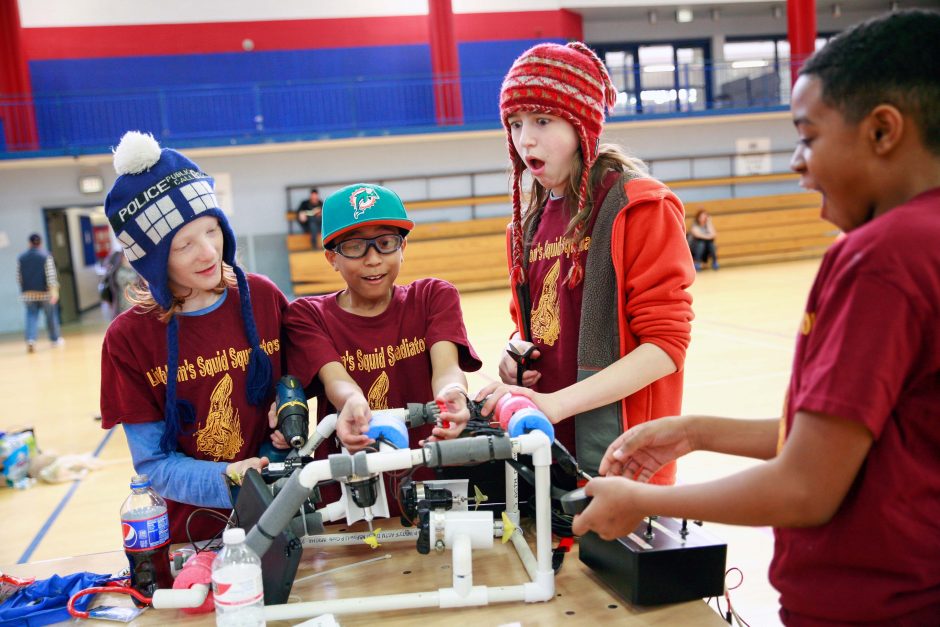
An underwater robotics student team at work. (Credit: Shedd Aquarium)
This summer, the team from the Shedd Aquarium in Chicago began pilot programs designed to reach local communities in a new way. Specifically, they ran excursions on both Lake Michigan and the Chicago River using ROVs equipped with underwater cameras and other tools to introduce more land-dwellers to what lies beneath the water.
Shedd Aquarium Learning Programs Manager Sadie Norwick and Communications and Public Relations Coordinator Kayley Ciocci spoke to EM about the Shedd’s innovative ROV programming for the public.
Inspiring conservation with technology
Although the pilot programs using the ROVs were new in 2018, the Shedd team is no stranger to using ROVs to educate the public.
“We’ve been using ROVs in programming for about 10 years now,” explains Norwick. “Our longest running program is our Shedd Underwater Robotics Club Program. In that program, we work with local schools, primarily in the Chicago public school system, and connect teachers and students to engineer, build, and design their own robots. So that’s been very exciting.”
In fact, although the aquarium provides many different types of programming, the Underwater Robotics Club Program is among their most popular. “We fill it each and every year and have a waiting list,” remarks Norwick.
The program allows students and teachers to work with underwater robots—not for one day, but all year long.
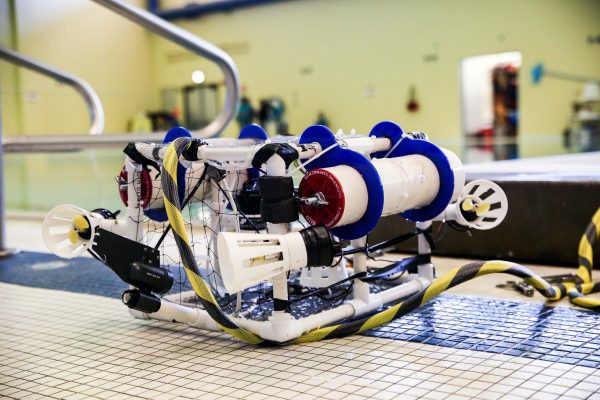
An underwater ROV built for a Shedd program. (Credit: Shedd Aquarium)
“We give teachers all the curricula, the supplies, and the support they need to be able to build their own robots,” details Norwick. “Then they go back to their schools and start their own in-class or afterschool clubs and have the students designing and building their own robots. Towards the end of the school year, all the clubs from the entire area, across all grades, get together to showcase their robots, get them in water, and connect with scientists and others that use underwater robots in their work. It’s a great celebration event.”
Although it’s definitely fun and exciting, the work students and teachers do in this club is far more than play. Underwater robotics allows students to envision themselves in a wide range of possible future careers while learning about science, technology, engineering, and math.
“Not only are they building robots, but when you add in the need to waterproof them, it’s an additional challenge,” Norwick describes. “These students are incredible, and it’s not only the engineering and science process. We also see teamwork, communication, and leadership; those skills that students are going to need to be successful in life emerge through programming like this.”
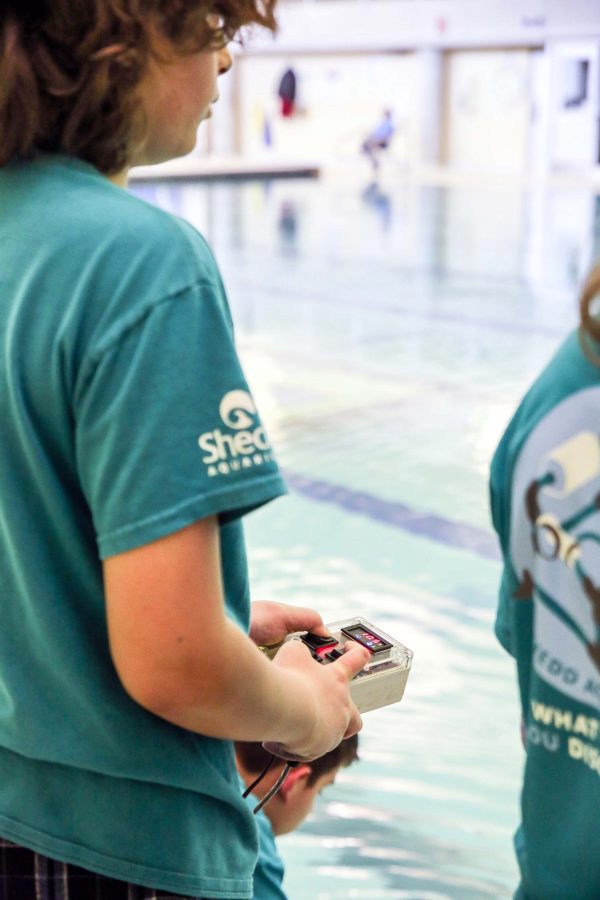
Teams control their underwater ROVs with remotes. (Credit: Shedd Aquarium)
Many participants stick with the program for years, and it all comes together at the Shedd.
“We are a regional site for an international competition, and we see groups that have been with us throughout the whole ten years,” remarks Norwick. “They start maybe with building robots from PVC frames and store-bought motor kits, and they progress to using really advanced technologies such as Arduino, computer programming, and 3D printing; it’s pretty incredible.”
Sparking compassion and curiosity
The Shedd team sees a relatively simple ROV as a smart way to “hook” new learners of all ages.
“The ROV that we used during the summer for the urban outpost program, and is also used in a wide variety of programming, is a VideoRay Scout,” states Norwick. “It’s a professional grade ROV that’s very easy to use, and is an easy way to connect our learners to the underwater world.”
One of Norwick’s favorite uses for the Scout is the Shedd’s High School Marine Biology Program.
“For that program, we take teens down to the Bahamas aboard Shedd’s research vessel, the Coral Reef II,” explains Norwick. “In that program, students are really immersed in being a field scientist for a week. They learn all sorts of different scientific techniques, including using an ROV to do research. It’s a great program, because it really gives them the experience of what it’s like to be a scientist, and it sets them up for that next step in their education and their career.”
This sort of community education and outreach is part of the mandate of the Shedd.
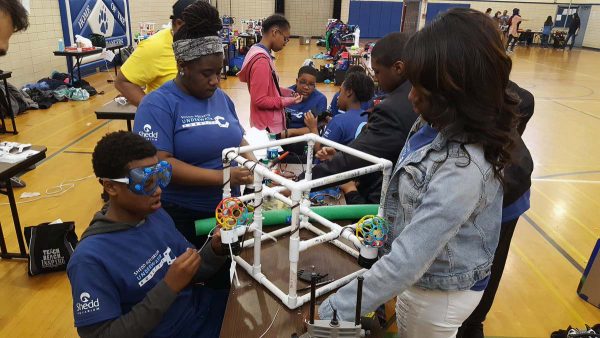
A team of students work on their ROV. (Credit: Shedd Aquarium)
“We view ourselves as an education and conservation organization, providing education to the entire Chicago community and beyond,” adds Norwick. “Connecting with guests that walk through our door, to teens, to communities, to teachers, to really anyone we can have an impact on, is one of our goals.”
The unique challenges the team faces in the Great Lakes region, from a conservation perspective, enrich that outreach work—and meeting those challenges prompted the team to use ROVs in programming.
“One challenge we face and we meet and are trying to meet, even more, is awareness, and really getting our community connected to our waterways,” details Norwick. “That’s why we did the urban programs this summer, to get more people to actually see what’s under the waves. We were intentional about using ROVs. You don’t have to dive in, and you don’t have to have scuba skills or even snorkel skills, you can just connect right away and see the fish and the plants, and see what’s below the water. Creating that little spark of compassion and curiosity helps lead to conservation.”
It’s not always easy motivating people to love nature and conserve it in an urban setting, especially one that has had its share of environmental troubles over time. This concept lies close to the heart of the ROV and other programs.
“We have an At Home on the Great Lakes exhibit that we’ve been using onsite here at the Shedd, and that’s one way that we’re connecting people to what’s in their backyard as well,” remarks Ciocci. “There’s even a ‘Sturgeon Touch‘ activity that’s part of the exhibit where people are able to look into that animal’s eye, and reach out and touch it. That onsite exhibit is a way that we’re opening people’s eyes to what the Great Lakes mean, and what animals are living there.”
This broad approach of engaging the community in conservation and citizen science pays off for the Shedd, sometimes in unexpected ways. A case in point: the team now has and uses custom ROVs that can’t be found anywhere else—and that’s all thanks to their programs.
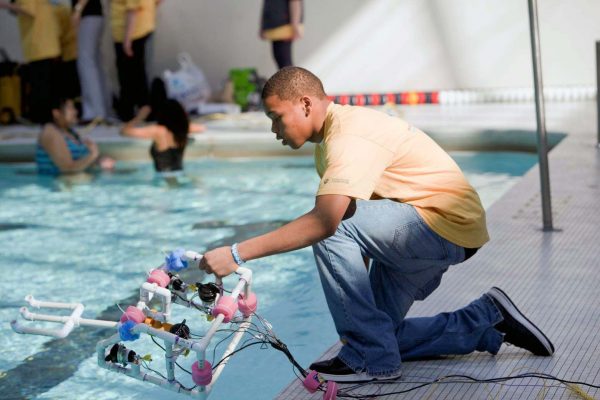
A student deploys an ROV. (Credit: Shedd Aquarium)
“In addition to the VideoRay, we also have a bunch of student and teacher-made ROVs that have been built here throughout the years,” Norwick mentions. “Those are some of my favorites because they’re the most creative. An ROV can be simple, just some motors, and then you can start to add lights and cameras. They can be designed and engineered to really perform whatever task you want them to. The innovation created by students is very impressive.”
The Shedd team hopes that more people—whether they’re scientists or not—will make use of ROVs to explore the world beneath the water’s surface.
“Technologies like this can go places that people can’t, and connect us in really unique ways to a whole new world underwater,” remarks Norwick. “There are so many opportunities, for exploration, for fun, for careers. It’s a really exciting technology to explore and to have, and they can come check it out here at the Shedd.”
Top image: An underwater robotics student team at work. (Credit: Shedd Aquarium)




0 comments